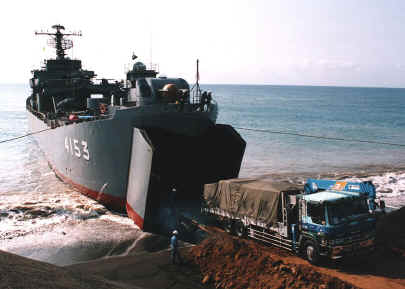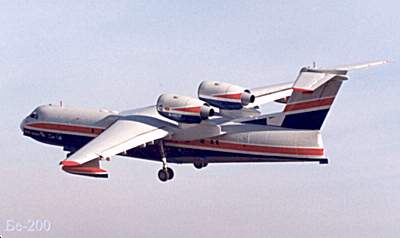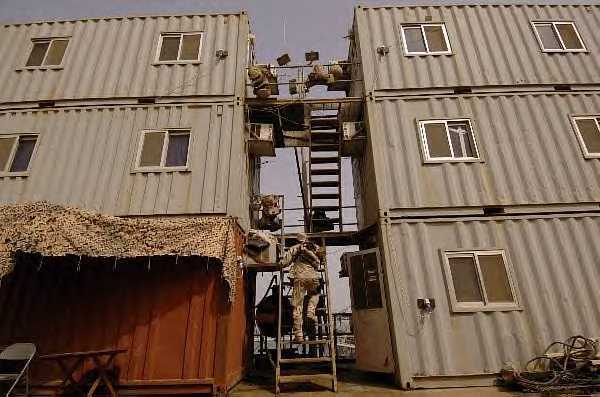Readers must familiarize themselves with these subtopics to understand the concepts discussed in this chapter. These articles are linked within this chapter, but it may be easier to read them in advance.
The Fast Sealift Myth - faster is not always better
CL-130 Seaplanes - can land almost anywhere
Landing Ship Tank - power projection ships
Thoughts on Seabasing - good and bad
Bunker Barges - the best way to move fuel ashore
Liberty Ships - are needed for morale
___________________________________________________________
This chapter covers overseas bases, rapid deployment, strategic lift, and force sustainment. These are components of projecting power through expeditionary operations. This chapter does not discuss the complexities of forcible entry, where a military must fight its way onto land, which is covered in Chapter 9. These may not seem like topics for future warfare, but these issues are just as important as warfighting itself. This is a huge topic, so this chapter discusses areas where improvements are needed.
The United States is keen on rapidly deploying military forces around the world. One element is to keep forces based overseas. This is generally a bad idea because it is extremely expensive, especially if families are brought over for long tours. Families also present a problem if war occurs. Many servicemen may desert to ensure their families are safe. At the onset of World War II, one of the US Navy's greatest concerns was how to evacuate military families from the Philippines. Over 5000 American civilians were captured and thousands killed in the Philippines in 1942 as American forces fled in disarray from indefensible forward military bases. The US Army spent a great deal of money to keep warplanes forward-based there, only to have them easily destroyed on the ground by Japanese warplanes.
The modern US military has established so many base comforts that around 4000 personnel are need to operate a base that hosts just 1000 personnel assigned to operational units. The base must be guarded too, and most overseas nations are easy for enemy commandos to enter. Sending units overseas for a couple months of training is a good idea as it improves readiness and morale. They can draw upon pre-positioned stocks of equipment. The US military has embraced this idea of "bare bones bases" and closed a few ultra-expensive, fully outfitted, family friendly bases overseas in Europe. However, senior officers love the imperial flavor offered by overseas tours and are reluctant to close unneeded bases in nice areas like England, Japan, and Germany.
The US Air Force and Navy maintain dozens of overseas bases that are unneeded, and many are near potential enemies and vulnerable to attack. It is irresponsible to have ships and aircraft permanently based within range of a potential enemy's theater ballistic missiles and bombers. The US bases at Sasebo, Iwakuni, and Okinawa, Japan are prime targets as they face mainland Asia. If they are attacked, those servicemen will be more concerned about their families on base rather than warfighting. This is not to argue those bases should close completely, but the families should stay in the USA. Ships and aircraft can visit these bases for training, and must not be based there to serve as targets like US Army Air Corps aircraft that were destroyed on the ground at Clark Field in the Philippines in 1941.
Getting "Over There"
 Once a war seems inevitable or begins, the movement of men and material is the challenge.
A large ship can move around 200 times more per trip than a large
aircraft. Of course, aircraft can make several more trips, but an
aircraft costs as much as a ship to purchase and maintain, so moving cargo
by ship is far, far, less expensive. Therefore, some 95%
of military tonnage is always moved by ship, with aircraft moving people and small
time-sensitive items like mail and urgent spare parts. Generals have
always sought faster ships
to accomplish this task, but the fundamentals of ship design make this
impractical.
Once a war seems inevitable or begins, the movement of men and material is the challenge.
A large ship can move around 200 times more per trip than a large
aircraft. Of course, aircraft can make several more trips, but an
aircraft costs as much as a ship to purchase and maintain, so moving cargo
by ship is far, far, less expensive. Therefore, some 95%
of military tonnage is always moved by ship, with aircraft moving people and small
time-sensitive items like mail and urgent spare parts. Generals have
always sought faster ships
to accomplish this task, but the fundamentals of ship design make this
impractical.
One problem with large ships is they require deep water, modern ports to offload. These are not available in much of the world and if they exist, they are prime enemy targets. During the 1991 Gulf war, Iraq fired several semi-guided missiles at the Saudi port of Dhahran, and nearly hit a large amphibious ship full of ammo. Two solutions are old solutions, seaplanes and LST amphibious ships that can beach themselves and lower a ramp to off-load vehicles. Both were used extensively during World War II, yet are rare today. Any nation can greatly enhance their expeditionary capability with seaplanes and LSTs. Interestingly, the expedition focused US military has neither of these platforms in service, while the Japanese "self-defense" force has seaplanes and LSTs. (above) The Russians have developed a large jet-powered amphibious aircraft, the Be-200 (below) which is available on the world market.
 Rapid Deployment is a popular topic.
Politicians want problems resolved quickly, but Generals must explain the
problems of logistics and strategic lift, although most don't understand these
topics themselves. If modern seaports and airports are available and
free of enemy fire, in the first 30 days the US military can deploy one airborne
division (82nd), one armored division (3rd Mech), one Marine division, and one
armored (3rd ACR afloat) brigade.
Rapid Deployment is a popular topic.
Politicians want problems resolved quickly, but Generals must explain the
problems of logistics and strategic lift, although most don't understand these
topics themselves. If modern seaports and airports are available and
free of enemy fire, in the first 30 days the US military can deploy one airborne
division (82nd), one armored division (3rd Mech), one Marine division, and one
armored (3rd ACR afloat) brigade.
During the next 60 days, another two army divisions and a second Marine division can be deployed; which is about the same rate as the 1990 rapid deployment to Saudi Arabia. At this point, most of the US strategic lift must be devoted to sustaining these six divisions, along with supporting Navy and Air Force components. As a result, it is difficult to justify funding ten active duty Army divisions ready to fight tomorrow since most cannot be deployed for six months anyway! Six months is plenty of time of mobilize and train up an Army reserve or National Guard unit.
Deploying more forces depends on the combat demand for ammunition, local water-food-fuel availability, any pre-positioned stocks, the potential to contract for additional sea and airlift, and the ability to keep old reserve sealift ships manned and running. Deploying six divisions within 90 days is optimistic because without modern seaports and airports, the most the USA can deploy and support is one airborne and two Marine divisions. This assumes the US Navy has no trouble keeping sea lanes open.
In many cases, it is better to position arriving forces for a counteroffensive rather than attempting to blunt an advancing enemy spearhead. This was the basic idea behind the landing of US Marines at Guadalcanal in 1942 and the amphibious landing at Inchon in 1950. In both cases, rapidly deploying forces pushed into the enemy's extended flank rather than attempting to repulse his offensive thrust. Deploying forces directly from the United States into a major combat operation is complex and risky. This is why the US Army first deployed to England and Africa during World War II, before launching major offensives into the continent.
The counteroffensive is the ideal strategy for most rapid deployment forces. Early arriving forces are light and lack supplies needed for prolonged defensive engagements. Tossing them piecemeal in front of enemy spearheads is foolish. Even mighty American airborne forces considered themselves mere "speed bumps" if Iraqi armored divisions had pushed south from Kuwait in 1990. Counterattack is a better strategy as the further enemy forces rapidly advance, the more vulnerable they become. Of course politics comes into play as enemy objectives may be deemed essential to defend.
Staying "Over There"
The biggest challenge to sustaining a modern expeditionary force is providing fuel. The fuel needs of the US Army have grown from 30% of all tonnage in World War II up to 70% today because equipment has become much larger. A lack of fuel stalled many offensive operations during World War II, yet the US Army now burned 12 times more fuel per soldier in Iraq than it did in France in 1944. A primary focus in designing a future war machine should be finding ways to improve fuel efficiency.
In 2005,
the
Department of Defense had 27,000 vehicles in Iraq and every one of
them had poor gas mileage. To power that fleet, the Defense Logistics Agency moved huge quantities of fuel into the country in truck convoys from Kuwait,
Turkey, and Jordan. All that fuel gave American soldiers a tremendous
battlefield advantage in communications, mobility, and firepower. But overseeing and carrying out this process required the work of some
20,000 American soldiers and private contractors. Every day some 2000 trucks left Kuwait alone for various locales in Iraq.
In addition to the challenges posed by the volume of fuel needed,
logisticians must deal with the sheer variety of fuels. Although the Pentagon tried to reduce the number of fuels it consumes, and now relies primarily on
a jet-fuel-like substance called JP-8, the Defense Energy Support Center supplied fourteen kinds of fuel to
US troops in Iraq. In short, the American GI is the most energy-consuming soldier ever seen on the
field of war. From computers and GPS units, trucks and helicopters, the modern
soldier is in constant need of energy: battery power, electric power, and
petroleum. The US military used about 1.7 million gallons of fuel a day in Iraq
in 2005, so each of the 150,000
soldiers on the ground consumed roughly nine gallons of fuel a day.
Since fuel accounts for most of an army's logistical requirement, expeditionary forces need bunker barges to move fuel from tankers offshore and serve as fuel storage tanks. Another challenge for an expeditionary force is providing shelter for forces that arrive in theater. This is an immense problem that often results in massive tent cities where morale declines as troops live in wretched conditions. This has generated interest in seabasing, which is generally a bad idea and impractical for major military conflicts. Rapidly deployed troops usually deploy to a sparse and chaotic environment where many of their important personal needs are ignored. This is why expeditionary forces need Liberty ships.
Commercial cruise ships are excellent expeditionary platforms and were used extensively as troopships during World War II. Many are larger than aircraft carriers and can accommodate up to 3800 guests. However, soldiers will not be guests, so they can "hot bunk" i.e. share bunks so the ship can carry twice as many soldiers. They should be chartered at the onset of a conflict and used as troopships. They can remain in port for days or weeks until accommodations are available for troops elsewhere. In contrast, troops arriving by aircraft are dropped off at airfields and left to fend for themselves. In addition, troopships can quickly extract thousands of troops should the military situation deteriorate.
Cruise ships are normally busy and chartering them on short notice is difficult. In addition, ship crews may object to service on a combat transport. One option is to buy some older cruise ships and place them in the naval reserve. However, since the United States routinely rotates units overseas for training by air, it may be cheaper to procure some used cruise ships as troopships for normal peacetime use. This will instantly add sealift capability and provide a portside hotel for peacekeeping forces overseas. Troopships are also useful when no major airstrip is near an area of conflict or when aircraft or airfields are threatened by insurgent heavy machine guns or shoulder-fired anti-aircraft systems. This became such a concern toward the end of the US intervention in Somalia that all troops were withdrawn by ship.
 Another idea is to procure thousands of common, metal ISO shipping
containers. Each can be fitted as living quarters or customized to serve
as kitchens, showers, headquarters, office space ect. The US Navy used
this housing concept in recent years (right) and the US Army has purchased some
for use in Iraq.
Another idea is to procure thousands of common, metal ISO shipping
containers. Each can be fitted as living quarters or customized to serve
as kitchens, showers, headquarters, office space ect. The US Navy used
this housing concept in recent years (right) and the US Army has purchased some
for use in Iraq.
These containers permit instant deployment to war zones and allow units to easily relocate to another base. They can also be used to convert common commercial container ships into troopships. ISO containers are designed for easy transport by truck, rail, sea, aircraft, and even helicopter. They provide immediate shelter without the time, cost, and manpower required to construct flimsy camps out of wood and tents. In addition, the metal provides protection from missile and artillery fragments. Empty commercial ISO containers are very inexpensive. In fact, they began to pile up at American ports when shippers abandoned them after realizing it cost them more to haul empty containers back to Asia; a result of America's massive trade deficit. American ports then required shippers to haul them away, so such containers can be acquired for free and fitted for military use.
Planners must recognize that troops do not have to deploy along with their major equipment. The moment a soldier arrives in theater, he becomes a logistical burden. Soldiers need not deploy until they are needed. So if a deployment plan will take four months to move a Corps size unit overseas, planners should hold back most of the combat troops until the last month. For example, the heavy vehicles for an armored division may deploy by ship with a thousand or so soldiers. When the equipment arrives, they can offload it and move it to a staging area. There is no reason for thousands of other combat troops to deploy by air at that time to sit with their equipment for months, unless that area is threatened by the enemy.
If an area is threatened by an enemy, ample supplies of ammunition and food must be sent before the troops and their equipment. If an enemy attacks, ammunition can be blown up, unlike troops with no ammunition or food. Since ammunition consumption is very low during peacetime, deploying stocks of needed ammunition is usually the greatest restraining factor for expeditionary forces that expect to fight a large military force. Ammunition is dangerous to move and often scattered in various bunker complexes. Shortages always exist, so military operations may be delayed for months until the needed ammunition can be manufactured and shipped overseas. During the last three major military operations, the US Air Force ran short of bombs after just three weeks of combat against third rate opponents.
The United Nations is often involved in expeditionary operations or at least overseeing them. These are often ineffective because diplomats love to assemble a large coalition of nations for the effort, so each contributes a small force. However, coordinating military operations among units from nations that speak different languages and use different equipment is a nightmare. This has been recognized in some cases, so a major power is tasked as the lead nation. Generals should push diplomats further by demanding that UN expeditionary forces always be organized in "blocs" of the same language. Spain or Mexico can become lead nations with components from Latin American nations. France can lead units from French speaking nations. Saudi Arabia or Egypt can lead Arab contingents. This is the best method in which the UN can deploy effective military forces.
Back to the Future
Most of what has been covered in this chapter were issues back in World War II. A future war will find military planners looking at lessons learned from World War II for solutions to problems they face. For example, during World War II the US military in the South Pacific learned to rapidly build hard surface runways with no concrete. They dredged up live coral from a bay, crush it in quarry machines, laid it out on a runway, and watered it with seawater for several days. The live coral would quickly grow together and form a hard surface, which remained hard after it died when the watering stopped. It is doubtful that today's military engineers have heard about that brilliant idea.
Discussion of overseas bases, rapid deployment, strategic lift, and force sustainment may seem odd for a book about future warfare. However, this is an area of frequent neglect by peacetime military forces. For example, two years after the invasion of Iraq, 30% of the cargo moved by American trucks was bottled water because the US Army still didn't have enough water purification equipment to sustain its force. A military force may be equipped with the best weaponry on Earth, but if they cannot deploy where needed and supported with basic items like fuel, food, ammo, and water, they are useless.
©2015 www.G2mil.com